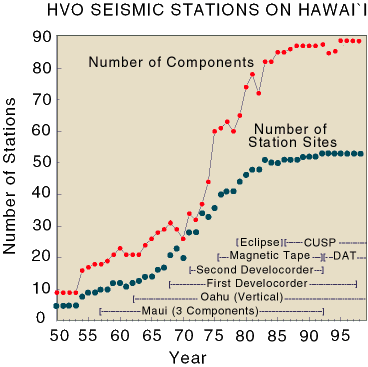
|
|
HVO Seismic Network
Seismic monitoring of the active Hawaiian volcanoes began in 1912. Since then, the seismographic network operated and maintained by the U.S. Geological Survey's Hawaiian Volcano Observatory (HVO) has expanded to over 60 stations on the Big Island. Data from remote stations are continuously telemetered in real-time to HVO.
HVO's network coverage is most dense on Kilauea. A sparser network of stations covers Mauna Loa and the other active volcanoes, Lo`ihi and Hualalai. The seismic network is set up to monitor volcanic and tectonic features on the island of Hawai`i.
Instumentation and recording
The network consists principally of instruments that are most sensitive to local earthquakes. We are engaged in a continuing effort to upgrade the network to include seismometers that are capable of recording a much wider range of seismic signals, including some of very long wavelength, and to incorporate microwave technology for transmitting greater amounts of data to HVO.
Each telemetered station has a voltage-controlled oscillator (VCO) for FM multiplex transmission to HVO by radio. After discrimination at the receiver, the analog signals are converted to digital form as part of the routine computer location processing and archiving.
At HVO, the telemetered seismic signals are automatically detected and processed in near-real-time by the CUSP (California Institute of Technology-USGS Seismic Processing) routine. Hands-on, interactive data analysis follows to confirm and refine the automatic estimates. Data are then archived onto magneto-optical disks. Continuous data are also written onto digital audio tape.
History
Optical drum seismographs were maintained at Uwekahuna (HVO) and Hilo. These less sensitive optical records were used primarily to measure amplitudes for magnitude calucations to supplement reading from the high-gain stations. A helicorder drum seismograph is still maintained on Oahu (Honolulu station operated by the Pacific Tsunami Warning Center).
Analog signals from selected stations were recorded on Develocorder A and B, using 16-mm microfilm. FM signals from the telemetering network were recorded directly on one-inch magnetic tape. September 1992 marked the discontinuation of the one-inch magnetic tape recorder, Develocorder B, and the optical drum seismographs at Uwekahuna Vault. Hilo seismographs were discontinued in October 1993. The magnetic tape recorder was replaced by three 4-mm digital-audio tape (DAT) recording units. The DAT recorders run continuously, in automatic rotation, as each 30-hr tape is filled. Develocorder A was discontinued in September 1997. A substitute for the develocorder is now in development.

Number of Components and Number of Station Sites by Year
Contact: hvowebmaster@usgs.gov
Updated: 18 June 2001 (pnf)

